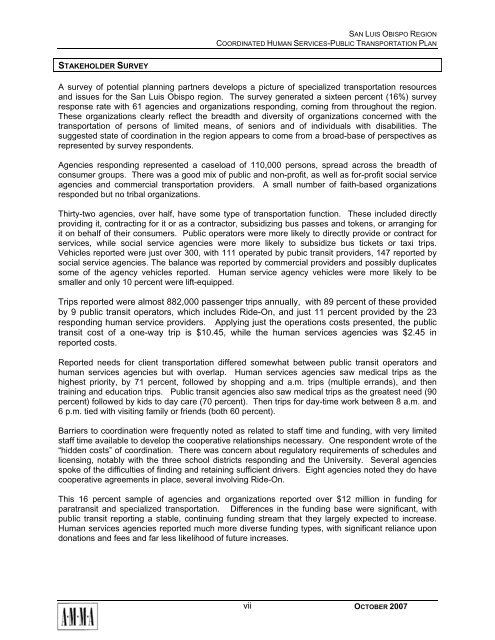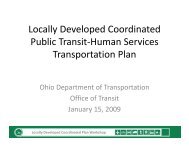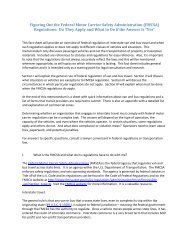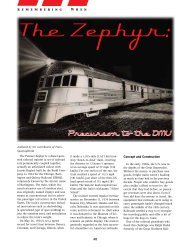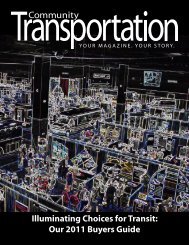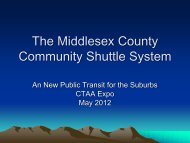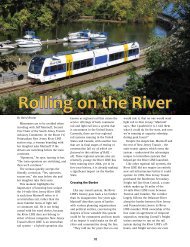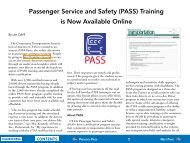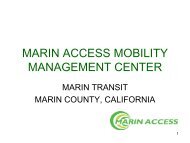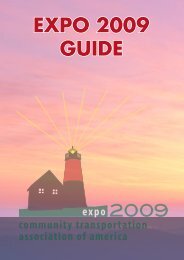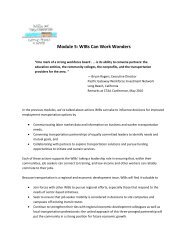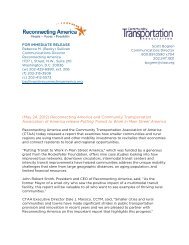San Luis Obispo - Caltrans - State of California
San Luis Obispo - Caltrans - State of California
San Luis Obispo - Caltrans - State of California
Create successful ePaper yourself
Turn your PDF publications into a flip-book with our unique Google optimized e-Paper software.
SAN LUIS OBISPO REGION<br />
COORDINATED HUMAN SERVICES-PUBLIC TRANSPORTATION PLAN<br />
STAKEHOLDER SURVEY<br />
A survey <strong>of</strong> potential planning partners develops a picture <strong>of</strong> specialized transportation resources<br />
and issues for the <strong>San</strong> <strong>Luis</strong> <strong>Obispo</strong> region. The survey generated a sixteen percent (16%) survey<br />
response rate with 61 agencies and organizations responding, coming from throughout the region.<br />
These organizations clearly reflect the breadth and diversity <strong>of</strong> organizations concerned with the<br />
transportation <strong>of</strong> persons <strong>of</strong> limited means, <strong>of</strong> seniors and <strong>of</strong> individuals with disabilities. The<br />
suggested state <strong>of</strong> coordination in the region appears to come from a broad-base <strong>of</strong> perspectives as<br />
represented by survey respondents.<br />
Agencies responding represented a caseload <strong>of</strong> 110,000 persons, spread across the breadth <strong>of</strong><br />
consumer groups. There was a good mix <strong>of</strong> public and non-pr<strong>of</strong>it, as well as for-pr<strong>of</strong>it social service<br />
agencies and commercial transportation providers. A small number <strong>of</strong> faith-based organizations<br />
responded but no tribal organizations.<br />
Thirty-two agencies, over half, have some type <strong>of</strong> transportation function. These included directly<br />
providing it, contracting for it or as a contractor, subsidizing bus passes and tokens, or arranging for<br />
it on behalf <strong>of</strong> their consumers. Public operators were more likely to directly provide or contract for<br />
services, while social service agencies were more likely to subsidize bus tickets or taxi trips.<br />
Vehicles reported were just over 300, with 111 operated by pubic transit providers, 147 reported by<br />
social service agencies. The balance was reported by commercial providers and possibly duplicates<br />
some <strong>of</strong> the agency vehicles reported. Human service agency vehicles were more likely to be<br />
smaller and only 10 percent were lift-equipped.<br />
Trips reported were almost 882,000 passenger trips annually, with 89 percent <strong>of</strong> these provided<br />
by 9 public transit operators, which includes Ride-On, and just 11 percent provided by the 23<br />
responding human service providers. Applying just the operations costs presented, the public<br />
transit cost <strong>of</strong> a one-way trip is $10.45, while the human services agencies was $2.45 in<br />
reported costs.<br />
Reported needs for client transportation differed somewhat between public transit operators and<br />
human services agencies but with overlap. Human services agencies saw medical trips as the<br />
highest priority, by 71 percent, followed by shopping and a.m. trips (multiple errands), and then<br />
training and education trips. Public transit agencies also saw medical trips as the greatest need (90<br />
percent) followed by kids to day care (70 percent). Then trips for day-time work between 8 a.m. and<br />
6 p.m. tied with visiting family or friends (both 60 percent).<br />
Barriers to coordination were frequently noted as related to staff time and funding, with very limited<br />
staff time available to develop the cooperative relationships necessary. One respondent wrote <strong>of</strong> the<br />
“hidden costs” <strong>of</strong> coordination. There was concern about regulatory requirements <strong>of</strong> schedules and<br />
licensing, notably with the three school districts responding and the University. Several agencies<br />
spoke <strong>of</strong> the difficulties <strong>of</strong> finding and retaining sufficient drivers. Eight agencies noted they do have<br />
cooperative agreements in place, several involving Ride-On.<br />
This 16 percent sample <strong>of</strong> agencies and organizations reported over $12 million in funding for<br />
paratransit and specialized transportation. Differences in the funding base were significant, with<br />
public transit reporting a stable, continuing funding stream that they largely expected to increase.<br />
Human services agencies reported much more diverse funding types, with significant reliance upon<br />
donations and fees and far less likelihood <strong>of</strong> future increases.<br />
vii<br />
OCTOBER 2007


